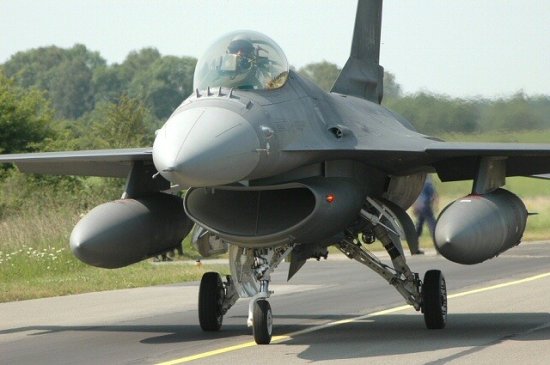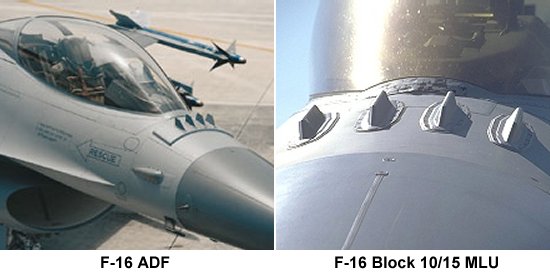|
||||||||||
|
|
||||||||||
|
||||||||||
|
|
||||||||||

This particular antenna arrangement is used on only a couple of F-16 models. The first was the F-16 Air Defense Fighter (ADF) version. This model was converted from the F-16 Block 15 for use as a fighter interceptor for the US Air National Guard. A total of 271 F-16A and F-16B aircraft were upgraded to this standard between 1989 and 1992. One of the modifications made during the conversion process was installation of the Teledyne/E Systems Mk.XII Advanced IFF system, given the designation APX-109. This system included four antennas, often nicknamed "bird slicers," placed in front of the cockpit canopy with additional antennas on the bottom of the inlet.
Another important change made as part of the ADF conversion was an upgrade to the APG-66 radar to provide look down/shoot-down capability for the AIM-7 Sparrow and AIM-120 AMRAAM missiles. Redesignated as the APG-66A, the modification also provided improved detection of small, high-speed targets like cruise missiles. A Bendix King ARC-200 high frequency single-sideband (HF/SSB) radio with Have Quick II Secure Speech Module was also installed in the vertical fin. This radio took the position that had been occupied by hydraulic rudder actuators, and these were relocated to the sides of the dorsal housing. One way to identify the F-16A ADF model is by long, thin horizontal bulges in the dorsal housing, shown in the above photo, that cover these actuators. The ADF can also be distinguished by a 150,000 candlepower night identification spotlight that helps identify planes at night. This spotlight is located ahead of and below the cockpit on the left side of the nose. Note that F-16B aircraft converted to the ADF standard are not equipped with the ARC-200 radio or the Advanced IFF system so they do not feature the fin bulges or the antennas in front of the cockpit.
The ADF model was originally built to defend the continental United States from nuclear bombers. That mission faded away with the end of the Cold War and the F-16 ADF aircraft began to be retired almost as quickly as they were built. Because of their modern features and little flight time, they have proven attractive on the export market and many have since found their way into foreign air forces. F-16 ADF aircraft have been sold or leased to Jordan, Thailand, and Italy.

Another version of the F-16 equipped with similar "bird slicer" antennas is the Block 10/15 MLU. The Mid-Life
Update (MLU) was an upgrade program for F-16A and F-16B Block 10 and Block 15 production models sold to various
NATO members. This update, not applied to any US aircraft, saw the installation of several new avionics systems
bringing the planes almost up to the Block 20 standard. These aircraft were also equipped with a new IFF system,
but the antenna mountings are slightly different than those used on the ADF model as indicated in the above picture.
- answer by Jeff Scott, 24 December 2006
Related Topics:
Read More Articles:


|
Aircraft | Design | Ask Us | Shop | Search |

|
|
| About Us | Contact Us | Copyright © 1997- | |||
|
|
|||